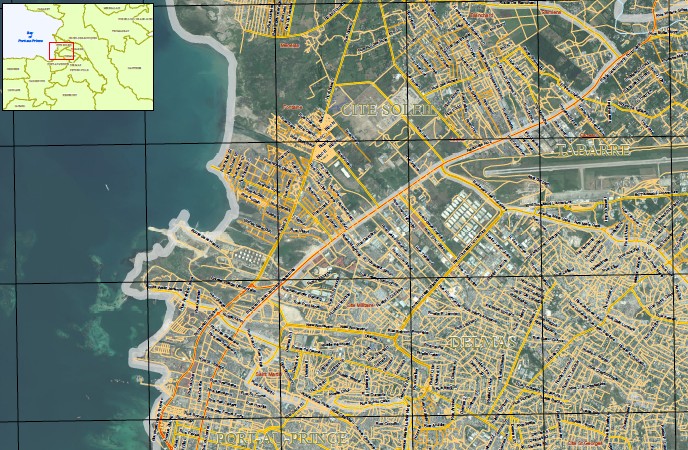
By Amy Hunter
The densely populated and violent Cité Soleil is located on the northern perimeter of Haiti’s capital. It is bordered by the vestiges of an industrial zone and by the UN Stabilization Mission, isolating it from other communities and helping to contain its violence. Originally built to house manual laborers, it expanded in the 1980s as textile and assembly industries developed. Many of Haiti’s unemployed came in search of work. After the 1991 coup d’état, the United States instituted economic sanctions against Haiti which effectively shuttered the export-based factories. Cité Soleil became a slum characterized by endemic unemployment, violent crime, unsanitary conditions, and non-existent essential services. Few residents are literate. Its population of 300,000‚àí450,000 (Wyler, 2009; Crisis Group, 2009) lives within 5 kilometers square. The area sits beneath hillside suburbs from which refuse runs down and is transported through Cité Soleil via open trenches flooded with sewage and debris. The area has little, if any, electricity (Economist, 2007), no sewers, no shops, no form of employment, and no police. What had formerly been the police station was looted and set afire and now serves as a latrine. Densities are high and poverty is rife‚ àí70% of households house more than four members; 81.4% are unable to feed their households; 86% are unemployed; 56% have less than 8 years of schooling (Barcelo, Jean Yves 2011); 70% of the children do not attend school (UNICEF, 2010). Cité Soleil is a microcosm of the poverty in Haiti against a backdrop of gang related lawlessness.
Absence of economic activity renders its residents below, the already low, Haitian poverty level‚àíhalf of the population survives on less than a dollar a day (Ponsar et al., 2009). Residents rely on mud baked in the sun for nutrients garnered from the soil (Economist, 2006) and humanitarian aid for food and basic health care. The extreme poverty and social marginalization render the residents vulnerable to mobilization by gang forces, the slum’s largest employer, which offer money and firearms‚àíadding insecurity to the challenges, particularly for women and girls who are increasingly victims. Children, lacking basic essentials, are easy targets and are brought into the gang’s workforce as messengers and soldiers (Willman,Alys 2010).
Cité Soleil is a humanitarian crisis in need of a development solution to satisfy the economic and social rights of its population and to reduce its dependency on humanitarian aid. A sustainable approach, balancing vision with immediate needs, should link community rebuilding with jobs, services and housing. Investment by Haitian government and international donors will need to focus on Cité Soleil as well as surrounding agricultural areas in order to generate employment and stem the flow of rural migrants to the slum. The strategy should end evictions and focus on livelihoods, promoting housing reconstruction based on improved practices and community-led environmental projects to expand access to clean water and basic sanitary conditions. Enhancing security should include a combination of Haitian National Police, UN police, and community policing. To ensure that residents have an invested stake in planning for the future, they need to be given a voice in this process. Haitian government needs to make the urban environment a national priority and link its rehabilitation and preservation measures to social and economic strategies.
This article is a product of Professor Shagun Mehrotra’s Global Urban Environmental Policy class. Views expressed are entirely those of the individual author.
References
Economist (2006). At last, a bridge of sorts to the future, 378 (8463), 33‚àí34.
Barcelo, J. Y., Masaud, A., & Davies, A. (2011). Meeting humanitarian challenges in urban areas No. 978-92-1-132364-1). Nairobi, Kenya: UN Habitat.
Crisis Group. (2009). Haiti: Saving the environment, preventing instability and conflict. International Crisis Group Policy Briefing, 20, 1‚àí16.
Global Logistics Cluster Support Cell (GLCSC) (2010). Haiti, southern cite soleil and northern delmas commune roads, area of interest, World Food Programme. http://epmaps.wfp.org/maps/04194_20100818_HTI_A2_GLCSC_Haiti,_Southern_Cite_Soleil_and_Northern_Delmas_Commune_Roads,_Area_of_Interest,_12_Aug_2010.pdf
Grossman-Vermaas, R., & Redding, D. (2010). Haiti stabilization initiative (HSI) evaluation Team’s phase 3 assessment for cite soleil. Soley Klere: Logos Technologies.
Ipsos (2009). Haiti: Opinion Survey and in-depth researchSource2009, ICRC/IPSOS, Geneva
Ponsar, F., Ford, N., Van Herp, M., Mancini, S., & Bachy, C. (2009). Mortality, violence and access to care in two districts of port-au-prince, haiti. Conflict & Health, 3, 1‚àí6.
Schneider, M. (2011, July 21). Haiti’s recovery stalled. The Miami Herald.
Willman, A., & Marcelin, L. H. (2010). If they could make us disappear, they would!, youth and violence in cit?© soleil, haiti. Journal of Community Psychology, 38(4), 515‚àí531.
Wyler, B. (2009). The haiti stabilization initiative: Base line and change. Conference Papers‚àíInternational Studies Association, 1.